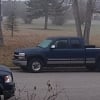-
Posts
41 -
Joined
-
Last visited
About NSFW
- Birthday 01/16/1980
Profile Information
-
Name
Kenn Cooper
-
Location
Foothills Alberta
-
Gender
Male
-
Drives
2000 Silverado 1500HD
NSFW's Achievements
-

Rear axle swap 1/2 ton to 3/4 ton
NSFW replied to ChevyToTheLevy's topic in 1999-2013 Silverado & Sierra 1500
A common axle is the GT5 3.73 which is semi-floating LSD and comes with rear disc. The switch from 4.10 to 3.73 will give the truck longer legs, but at a cost of torque. (like 14% from one to the other value respectfully) if you continue to run the same tire you were on the 10 bolt. If you are running a 245 with a 4.10, and you go to a 3.73 axle I know of a little trick: Reduce the sidewall profile from 245 to 235 and the spedo won't need to be re-calibrated. PLUS your torque values will return back to where they were with the 10 bolt. If you are running a 4.10 with 235 tire, you can reduce it to a 225 IF you don't mind loosing the sidewall. A 225 is a small tire on a 16 inch rim but options are options. The GT4 and GT5 differ in girth, (of course) but they differ majorly in input pinion length. About 3 inches different with the 5 being the longer. (requiring a shorter shaft) UNLESS you compensate with a lift kit. The bolt up is the same, and the e-brake's attach the same, brake line in the exact same spot. In which all of this lengthening and shortening evens out. You can switch the input yoke from the 4 to the 5.. Unbolt one, bolt on the other. The splines and the oil seal are the same and you can re-use your stock drive-shaft w/ujoints but it greatly reduces the plunge depth of the slip-yoke at the transmission. One HARD landing COULD break it. I have heard of folks swapping output tail shafts between the L480 and the L460 but I never tried it. Efforts to not play with the driveshaft. The other difference with the G80 is spring perch height. The 4 will be near flush with the top of the axle tube, where as the 5 will have about 1-1/2 inches on it. This will result in the needing of longer u-bolts, unless the spring pack is re-organized to compensate for the height difference. I would get the bolt flip kit, which re-locates the nuts to the top of the spring pack. The Axle Shafts 'COULD' be swapped out for correct bolt pattern shafts. A custom job of course. Bear in mind you would need to address the disk brakes, specifically rotors.. Which might halt ya. UNLESS you put the 4 brake setup on the 5 and matched it up with correct axle shafts. Might work. Never tried it. Would need to get the two axles in a welding shop and do some parts swapping. You could also get a machine shop to re-drill the rotors to accept the different bolt pattern. Weld the holes, re drill the holes, then relax and re temper the rotor.. I would put the GT5 in the rear of the truck, and convert the front to 2500 wheel outers (4 bolt hub) THAT'S a monkey of a job and though you can KINDA make it work.. over the long run it eats tires.. Its not as easy as just changing the wheel-bearings. Would be SO nice if it were that easy. All accounted for.. what I would do? Buy a damaged 2500 with a straight frame. Strip it. Take all parts off of your truck and put on new 2500 frame. you will end UP with a nicer truck in the end of it. Because you will be able to address ALL the prone rust issues with the frame WHILE you have the truck apart. Plus take care of the ABS problems.. and various other MFG shenanigans. from the top down.. OR.. find a 2004 2500 with a GT5 in it. -

Pitman / Idler Arm help needed
NSFW replied to number9l's topic in 1999-2013 Silverado & Sierra 1500
Puzzling... I'm gonna think on this. Somethings screwy here. -

Pitman / Idler Arm help needed
NSFW replied to number9l's topic in 1999-2013 Silverado & Sierra 1500
Bump-steer. Adjust the steering box tensioner to accommodate for waer/play/slop is the only thing I can think of right off the top of my head. That set to spec and I would check to see if there is excess play in the steering setup from the steering box to the steering wheel. However I don't believe play above the steering box that would chiefly relate to bump steer problems, but it might (the pitman arm being allowed to slap from side to side would make the truck bump steer). Bump steer problems, or sensitivity to bump steer issues are mainly caster adjustments. Caster is important, as it governs the behavior of the vehicles desire of self-centring steering and to drive in a straight line. the roads up here in Canada have a 3 degree crown engineered into them (even the big 2 lanes) and setting on 0-0 caster results in hand pressure applied to the left to make the vehicle go down the road or it starts to go right. Canada doesn't just exclusively set this 3 degrees and its standard everywhere. Dirt roads have less crown to prevent the dirt from being washed into the ditch. Dirt roads are usually 1 degree or flat. City drainage is about 3 to 6 degrees. In areas that don't get precipitation (like tunnels) there is no need for a surface crown. Take these circumstances, then rope it together with road surface quality that greatly varies from coast to coast, and its a very hard thing to do to get a vehicle to be aligned and work in all scenarios without causing frustration with the driver. SOME day, they will make adaptive alignment. A vehicle that looks at the road, and sets up the alignment to spec with what its scanner 'sees'. C'mon Musk.. get with it. Thinking about this post I went and took my truck for a drive. When I am in the right lane at speed the truck tracks straight, with a slight (I mean over 200ft travel) arc drift to the right. Meaning, my left hand is resting on the wheel and no left applied force by my arm is 'holding' the truck straight on the road. The weight of my hand resting on the left side of the wheel is all it takes to result in a straight driving track. I can switch hands, and the result is the same. When I take my eyes off the road, the truck doesn't wander. It just tracks straight. My caster adjustments are 5.2 degrees on the drivers side wheel, and 2.1 degrees on the passenger wheel. My split camber is .5 degree (.25 of a degree negative on each wheel) My ride height is lower then stock. But I should add its not the same for both sides of the truck. I measure out 1-1/2 inch from the top of the adjusting bolt head, to the threaded boss on the passenger torque rod, and 1-3/16 on the drivers side. I have .75-.9 degree toe in which pulls straight with the force of the rear tires pushing the works down the road. In the right lane the truck tracks straight, but in the passing lane, the truck pulls to the left, and I need to hold the wheel to the right to keep the truck driving straight. Allot of companies (including dealers) tech's don't follow basic analysis routines when aligning vehicles due to the prevalence of online or documented specs, pecking order at the shop, work flow and other things. But the level of the fuel tank, a toolbox that's always full of tools, a ladder rack. Weather the vehicle is full of people often play a factor. Usually an alignment is set up to do all things well, not any one thing well. True these stipulations don't usually effect alignment a whole hell of allot, but when a driver of a vehicle is 300lbs... and the vehicle tends to pull to the drivers side, alignment can correct 'MOST' of this. A bent receiver hitch, or a distorted hidden hitch mount, bad tongue, crappy alignment on the trailer be it goose neck or otherwise can lead to wierd driving traits, and wierd wear on the tires It's allot to take into consideration. my minds list on steering gear changeover (overhaul) wheelberings ball-joints outer tie's inner tie's drag link (whole component) pitman arm taper joint *steering box slack adjusted to spec *bushings in steering box play to spec *bushings in steering column including tilt to spec Followed by an alignment to spec, test drive, then final adjustments after test drive. The biggest problem that I experienced while performing my 1/2 tonne to 3/4 tonne changeover was finding an actual alignment shop that 'would' actually align the truck and not just take my money. Being that I don't work in the shop where I learned aligning thus not able to have access to thier LASER machine there, finding a shop that wasn't merely throwing the truck on the rack and adjusting it to computer spec was if not impossible to find. I ended up going thru a 4x4 shop, that does custom 4x4 work, and getting their alignment guy to help me set the truck up. After that it was good. Steering box tensioner. It's measured by using a drag indicator up at the steering wheel, not sure what the specs are, but there are specs for it. peace
-
Forum Statistics
246k
Total Topics2.6m
Total Posts -
Member Statistics
-
Who's Online 5 Members, 0 Anonymous, 591 Guests (See full list)




